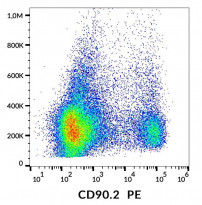ARG42274
anti-CD90.2 / Thy 1.2 antibody [1aG4/C5] (PE)
anti-CD90.2 / Thy 1.2 antibody [1aG4/C5] (PE) for Flow cytometry and Mouse
Overview
| Product Description | PE-conjugated Mouse Monoclonal antibody [1aG4/C5] recognizes CD90.2 / Thy 1.2 |
|---|---|
| Tested Reactivity | Ms |
| Species Does Not React With | Hu, Rat |
| Tested Application | FACS |
| Specificity | The mouse monoclonal antibody 1aG4/C5 recognizes alloantigen Thy-1.2 of mouse Thy-1 (CD90); it does not cross-react with Thy-1.1 alloantigen. Thy-1 is an 18-35 kDa cell surface GPI anchored glycoprotein (immunoglobulin superfamily); in mouse it is abundant on thymocytes and peripheral T lymphocytes. |
| Host | Mouse |
| Clonality | Monoclonal |
| Clone | 1aG4/C5 |
| Isotype | IgG3 |
| Target Name | CD90.2 / Thy 1.2 |
| Antigen Species | Mouse |
| Immunogen | Thymocytes from C3H/Di mice (CD90.2 / Thy 1.2 positive). |
| Conjugation | PE |
| Alternate Names | Thy-1 membrane glycoprotein; Thy-1 antigen; CD antigen CD90; CDw90; CD90 |
Application Instructions
| Application Suggestion |
|
||||
|---|---|---|---|---|---|
| Application Note | * The dilutions indicate recommended starting dilutions and the optimal dilutions or concentrations should be determined by the scientist. |
Properties
| Form | Liquid |
|---|---|
| Purification | Purified |
| Buffer | PBS and 15 mM Sodium azide. |
| Preservative | 15 mM Sodium azide |
| Concentration | 0.1 mg/ml |
| Storage Instruction | Aliquot and store in the dark at 2-8°C. Keep protected from prolonged exposure to light. Avoid repeated freeze/thaw cycles. Suggest spin the vial prior to opening. The antibody solution should be gently mixed before use. |
| Note | For laboratory research only, not for drug, diagnostic or other use. |
Bioinformation
| Database Links | |
|---|---|
| Gene Symbol | THY1 |
| Gene Full Name | Thy-1 cell surface antigen |
| Background | This gene encodes a cell surface glycoprotein and member of the immunoglobulin superfamily of proteins. The encoded protein is involved in cell adhesion and cell communication in numerous cell types, but particularly in cells of the immune and nervous systems. The encoded protein is widely used as a marker for hematopoietic stem cells. This gene may function as a tumor suppressor in nasopharyngeal carcinoma. Alternative splicing results in multiple transcript variants. [provided by RefSeq, Jul 2015] |
| Function | May play a role in cell-cell or cell-ligand interactions during synaptogenesis and other events in the brain. [UniProt] |
| Cellular Localization | Cell membrane; Lipid-anchor, GPI-anchor. [UniProt] |
| Calculated MW | 18 kDa |
Images (1) Click the Picture to Zoom In






